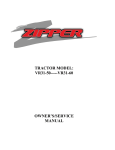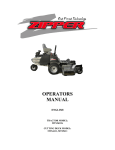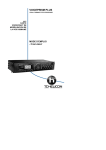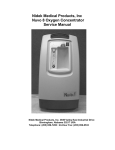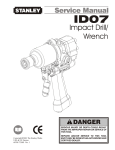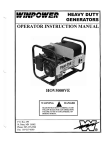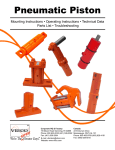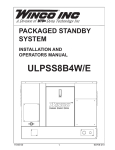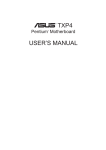Download TRACTOR TROUBLE SHOOTING GUIDE (CONT.)
Transcript
TRACTOR TROUBLE SHOOTING GUIDE (CONT.) SYMPTOMS High Oil Consumption PROBABLE CAUSES Numerous Causes SUGGESTED REMEDIES See Engine Manual SAFETY FIRST NOTE: DO NOT attempt to start the engine or operate this machine until you have read all safety information and operating procedures in this manual. Engine Knocks and Other Engine Noises This is a Safety Alert Symbol used to alert you to possible danger to you or someone else’s personal safety. Be alert to the accompanying messages in this manual. Electric Clutch Will Not Engage Grass Cut Uneven Loose or Faulty Wiring Seat Switch Faulty Clutch Out of Adjustment Deck Height Adjustment Not Even on Both Sides Tire Pressure Uneven Check Wiring Change Seat Switch See Your Dealer Adjust Height Check Tire Pressure CAUTION: Your ZIPPER is equipped with an Ignition Interlock Safety System. This system is designed to protect the operator and others in the immediate area by preventing the engine from starting when the PTO switch is on or the Steering Levers are not in the locked position. IMPORTANT Listed below are a common set of rules you should read and follow. REMEMBER, your safety and the safety of others depends on the operator’s awareness and adherence to these basic rules. 1. . 2. Know the controls and how to stop quickly. READ THE OWNERS MANUAL 3. DO NOT carry passengers. Keep children and pets a safe distance away. 4. Clear the work area of objects which might be picked up and thrown. 5. Disengage clutch and lock steering levers in neutral before attempting to start the engine. 6. Disengage clutch and stop engine before leaving the operator’s position. 7. Disengage clutch when transporting or not in use. 8. Disengage clutch and stop engine before making any repairs of adjustments. 9. Take all possible precautions when leaving the mower unattended, such as disengaging the PTO, lowering the deck, locking the steering levers in neutral, setting the parking brake, stopping the engine and removing the key. 10. DO NOT stop or start suddenly when going up or downhill. Mow up and down the face of steep slopes; never across the face. DO NOT allow children to operate the mower. DO NOT allow adults to operate without proper instruction. 11. Reduce speed and exercise extreme caution on slopes and in sharp turns to prevent tipping or loss of control. Be especially cautious when changing direction on slopes. 12. Always stay alert for holes, rocks, and roots in the terrain and other hidden hazards. 13. Watch out for traffic when crossing or near roadways. 14. When using any attachments, never direct discharge of material toward bystanders nor allow anyone near the mower while in operation. 15. TRACTOR TROUBLE SHOOTING GUIDE SYMPTOMS Starter Does Not Crank Handle gasoline with care (it is highly flammable) a. Use approved gasoline container. b. Never remove the fuel cap or add gasoline to a running or hot engine. Engine Cranks But Does Not Start PROBABLE CAUSES Ignition Interlock Safety System Not Engaged Safety Switch Faulty PTO Switch in On Position PTO Switch Faulty Weak or Dead Battery Fuse Blown For Additional Causes No Gas or Line Plugged No Fire at Spark Plug c. Do not fill tank indoors and wipe up any spilled gasoline d. Exhaust fumes are dangerous. DO NOT run the engine indoors. 16. Keep the tractor and attachments in good operating condition and keep safety devices working properly. 17. Keep all nuts, bolts and screws tight to be sure the equipment is in safe working condition. 18. Never store the equipment with gasoline in the tank inside a building where fumes may reach an open flame or spark. Allow engine to cool before storing in any enclosure. 19. To reduce fire hazard, keep the engine free of grass, leaves, or excessive oil and grease. 20. The tractor and attachments should be stopped and inspected for damage after striking a foreign object, and the damage should be repaired before restarting and operating the equipment. 21. DO NOT change the engine governor settings or overspeed the engine. 22. When using the mower, proceed as follows: a. Mow only in daylight or in good artificial light. b. Never make a cutting height adjustment while engine is running. c. Shut off engine when removing the grass catcher or unclogging the chute. d. Check the blade bolt tightness at frequent intervals. 23. Disengage power to mowing deck before backing up. DO NOT mow in reverse unless absolutely necessary and then only after careful observation of the entire area behind the mower. Engine Runs with Loss of Power or Excessive Black Exhaust Tractor Jerky When Starting or Tractor Operates in One Direction Only Hydraulic System Operating Hot Tractor Creeps When Steering Levers in Neutral Tractor Creeps or Veers in One Direction Tractor Creeps with Brake on. Engine Over Heating Engine Oil Pressure Low Numerous Other Causes Restriction in Air Cleaner Poor Compression or Timing Steering Cables Need Adjustment Hydraulic Pump or Wheel Motor Faulty Oil has been Contaminated with Water or Dirt Damaged or Broken Fan Cooling fins or Oil Cooler Plugged Hydraulic Pump Faulty Steering Cables Out of Adjustment Steering Cables Out of Adjustment Wheel Motor Faulty Brake Band Worn Intake Screen Clogged Cooling Fins Clogged Low Oil Level Oil Sending Unit Faulty Oil Diluted or Grade Too Light SUGGESTED REMEDIES Engage System Replace Switch Put Switch in Off Position Replace Switch Recharge or Replace Battery Replace Fuse See Owner’s Manual Fill Tank or Replace Line Clean or Replace Spark Plug See Engine Manual or Dealer See Engine Manual or Dealer Service Air Cleaner See Engine Manual or Dealer Adjust Cables See Your Dealer Drain Oil From System and Replace or See Your Dealer Replace Fan Clean Cooling Fins and/or Oil Cooler See Your Dealer Adjust Steering Cables Adjust Steering Cables See Your Dealer See Your Dealer Clean Screen See Engine Manual for Cleaning Add Oil See Your Dealer Change Oil and Check for Source of Contamination EXTERIOR SURFACE Dealer Preparation For Operation The machine should be washed regularly to maintain its appearance. WARNING: When washing the inside of machine, DO NOT direct water spray around the hydraulic oil tank breather cap. The mower deck should be cleaned after each day of use for best mowing results. Water pressure from a garden hose will clean the underside of the deck if the grass clippings have not dried. Otherwise, a putty knife or other flat object may be needed to remove dried clippings and dirt. IMPORTANT: Every 40 hrs or each week clean debris from inside deck covers. Failure to do this may cause damage to deck idler pulleys and/or the deck gearbox. WARNING: Do not operate machine without all guards and covers in place. STORAGE: To insure the machine will be ready for the next mowing season, the following steps should be taken when storing the machine at the end of the season. 1. Wash the machine to remove all grass, dirt and debris. 2. Visually inspect for any worn or damaged parts that need replaced and order them from your ZIPPER dealer. 3. Lubricate the machine according to lubrication instructions. 4. Lightly oil the underside of deck to prevent rusting. 5. Drain fuel tank and run engine to remove all gas from carburetor. 6. Perform other engine operations as outlined under storing engine in the engine manual. 7. Remove battery and store in a dry place. Protect the battery from freezing temperatures. Occasionally charging the battery during storage will extend battery life. 8. Store machine in dry place away from flames Customer Note: Your ZIPPER Dealer is Expected to complete the following predelivery operations and review all safety precautions in this manual with You before or upon delivery of this machine. NOTE: All references to “Right, Left, Front, and Back” are from sitting in the drivers seat. WHEELS Remove packing crate from the machine and install the drive wheels and tail wheel. Fill the tail wheel with grease BATTERY Connect positive cable first, then connect the ground cable. IGNITION INTERLOCK SAFETY SYSTEM DANGER: Failure of the IGNITION INTERLOCK SAFETY SYSTEM, together with operation of the machine could result in personal injury. Check the Interlock Safety System to make sure it is functioning properly. The engine must not start unless the steering levers are in the neutral locked position and the PTO switch is off. The engine must kill if the operator leaves the seat with the steering levers down and/or PTO switch in the on position. MACHINE CHECK LIST The following list should be performed before starting the engine on a new machine. 1. Check the engine oil level (see engine manual for oil recommendations) 2. Check the oil level in the hydrostatic oil tank located at the back of the engine cavity under the left hand control panel. The oil level should be 1” below the top of the tank. (See Hydraulic System for oil recommendations) 3. Fill fuel tank with fresh clean gasoline (see engine manual for recommended fuels) 4. Check tension on the hydraulic pump drive, deck drive, and blade drive belts. (see belt adjustment section for proper belt adjustments) 5. Check pressure in all tires ( see fig. 1) The drive wheels and gauge wheels must have equal pressure to maintain an even cut. TIRE PRESSURE PSI Drive Tires………………12-16 Tail Wheel……………….10-18 Gauge Wheel……………..8-12 Figure 1. INSTALL DECK The following steps are recommended for installing the deck: 1. Remove the deck from the shipping box and place on level surface in front of tractor. 2. Install gauge wheel brackets using 5/1618 carriage bolts, lock washers and hex nuts. Install gauge wheel adj. tube and deck adj. bolt and nut. Install grass chute by starting the hinge pin from the back of the deck through the first hinge on the grass chute and deck. Place the grass chute spring over the hinge pin and slide the hinge pin through thee front hinge on the deck and grass chute. Place the handle of the pin in the retainer on the grass chute and lock into place with the cotter hairpin. WARNING: Do not operate deck without grass chute spring installed. 3. Check the blade bolts to be sure they are tight. Also remove deck cover and check the deck belt tension. WARNING: Never operate the deck without grass chute and belt guard in place. 4. Remove (2) 1/2 bolts from lift arm ball joint and (2) 1/2 adj. pins from back of deck. 5. Remove belt guard from deck gearbox. 6. Raise deck lift to the middle position, align deck under arms and lower lift to down position. Install bolts through deck and ball joints. 7. Place drive belt over gearbox pulley and replace belt guard. 8. Raise deck lift enough to install adj. pins at desired cutting height. 9. Raise deck to full up position and install front gauge wheels and set mounts at desired cutting height. 10. Lower deck and adj. the deck drive belt. WARNING: Only operate the deck while sitting in the operator’s seat. Make sure the area is clear of all hazards, persons, and pets when running the deck REGISTRATION & DELIVERY Fill out the warranty registration card and mail the proper copy to ZIPPER MOWERS within 10 days. Warranty is registered under Model and Serial Number located under the front of the left hand control panel on the tractor and under the left hand deck cover on the deck. Upon delivery of the machine, go over all the controls and how to operate the unit as covered in this manual. Emphasize all the safety precautions covered in the manual. Both dealer and customer must sign the warranty registration card upon delivery. To Replace Deck Drive Belt NOTE: Also check the hydraulic pump belt at this time. It is a good idea to change both belts at same time. 1. Loosen arm retainer bolts on right arm only. Turn adjusting bolt counterclockwise to loosen belt. 2. Remove belt guard from gearbox. 3. Loosen clutch stop and slide fwd. Unplug wires to electric clutch. 4. Remove belt and install new one. 5. Reverse steps 1-3 6. Adjust belt tension (see Above). New belts should be rechecked after 5 hrs. 7. Adjust L/H deck arm to same length as R/H TRANSMISSION DRIVE BELT BLADE DRIVE BELT TO CHANGE: STEPS TO ADJUST BLADE DRIVE BELT 1. Shut off engine, remove key and set parking brake. 2. Loosen deck drive belt and remove from the electric clutch (see deck drive belt section) 3. Loosen transmission belt tension eye-bolt and remove old belt. 4. Install new belt and adjust tension 5. Replace deck drive belt (if old belt is worn it is a good idea to change at this time also) 6. Readjust clutch stop and attach clutch wire. 7. Adjust deck drive belt. 1. Remove L/H and large center deck cover. 2. Loosen nut on belt tightener retainer bolt. 3. Adjust tension bolt to obtain proper tension on belt. Deflection on longest span should be 5/8 from centerline with 5 lbs force. WARNING: Do not operate machine without all belt guards and deck covers in place. TO REPLACE BLADE DRIVE BELT 1. Loosen deck drive belt. 2. Remove all deck covers. 3. Loosen belt tightener retainer bolt and adjustment bolt. 4. Unbolt gearbox mount from deck and remove the belt from under gearbox pulley. 5. Loosen the 5” idler pulley and remove the belt from between the front spindle pulley and the 5” idler. 6. Replace with a factory replacement belt. 7. Place new belt around the two outer spindle pulleys and between the 5” idler and center pulley. Tighten idler at this point. 8. Place belt over the gearbox and reinstall the gearbox mount. 9. Adjust the blade drive (see above). Readjust new belts after 5 hours. 10. Replace deck covers 11. Adjust deck drive belt (see deck drive belt section) TO ADJUST: WARNING: Never check or adjust any belt with engine running. 1 2 3 4 Shut off engine, remove key and set parking brake. Loosen jam nut on tension eye-bolt (located on the upper hydraulic pump) Tighten nut on aft side of mount bracket to increase tension on belt. Belt should have 1/2 “ deflection with 5 lbs force. Tighten jam nut. STEERING CABLE ADJUSTMENT The machine has been set at the factory so that it will not creep forward or backward while the engine is running and the steering levers are in the neutral lock position. However, if the machine should begin to creep or one wheel runs faster than the other, adjustments must be made. Contact authorized ZIPPER dealer for steering cable adjustment. ELETRIC CLUTCH ADJUSTMENT A sign that the electric clutch is out of adjustment is when the clutch will engage with the clutch cool but not when the clutch is warm. Take machine to authorized ZIPPER dealer for clutch adjustment. DECK HEIGTH ADJUSTMENT BLADE CARE WARNING: shut off engine and remove key before adjusting cut position. DANGER: Never inspect of remove blades with engine running or key in ignition. Always remove key and set parking brake. Cutting height can be adjusted from 1”– 5” on all decks. To adjust, raise deck, remove front adj. nuts and bolts and place them in desired cutting height and replace bolts. Relieve pressure on rear pins using deck lift and remove pins and adjust back of deck. For best cutting results, in most conditions, the back of the deck should be 1/8” – 1/4" higher than front. For best results keep the mower blades sharpened. To service blades, tilt and lock deck using the EDLS (see tilting deck for service section). Do not sharpen blades while mounted on the spindles. Blades may be sharpened on a grinder or by filing. When grinding, care should be used to maintain blade balance. A blade balancer should be used after sharpening. Unbalanced or bent blades will cause excessive vibration and decrease the life of the deck WARNING: Never use any form of heat to straighten a bent blade. Never weld a cracked or broken blade- REPLACE THEM. BELT ADJUSTMENT. LUBRICATON WARNING: Never check or adjust any belt with engine running. NOTE: The best time to grease the bearings on your ZIPPER is right after you have completed mowing and cleaned the machine. NOTE: Do not over tighten any belt. A belt that is to tight will run hotter, create unnecessary side pressure on bearings and cause premature failure of belts and bearings. Use SAE multi-purpose grease on all grease zerks. DECK DRIVE BELT There are 9 grease zerks on the machine. The deck gauge wheel and tail wheel bearings should be greased every 8 hours. The spindle bearings and gauge fork and tail fork bearings should be greased every 40 hours Follow these steps to adjust. 1. Loosen the two arm retaining bolts on both deck arms. 2. Loosen the lock nut on the deck belt adjustment bolt. Turn the adjusting bolt clockwise to tighten the belt. Both arms must be adjusted the same amount when adjusting. The deck drive belt should have 1/2" of deflection from the centerline with 5 lbs. of force. 3. Retighten lock nuts on adj. bolts and tighten arm retainer bolts. MACHINE OPERATION NOTE: The design and configuration of equipment, hazard control and accident prevention are dependant upon the proper training of personal involved in the operation, transportation, maintenance and storage of the equipment. DO NOT let children or unqualified operators run the equipment. STARTING THE ENGINE NOTE: The PTO switch must be in the off position and the steering levers in the neutral lock position before the engine starter will engage. In this manual it will be referred to as the IGNITION INTERLOCK SAFETY SYSTEM. (IISS) WARNING: never operate this machine with the IISS disconnected, bypassed or malfunctioning. WARNING: Engine exhaust gases contain poisonous carbon monoxide. Avoid breathing fumes and never run the engine in a closed building or confined area. IMPORTANT: Always apply the parking brake before starting the engine. 1. Pull choke out to the CLOSED position. On a warm engine leave choke in the OPEN position. 2. Open throttle to half speed. 3. Turn ignition key to START. Return key to ON position as soon as engine starts. NOTE: The ignition switch has an integrated light switch so it has 2 ON positions; one is to turn on headlights. 4. Slowly push the choke down to the OPEN position after the engine starts to warm up. 5. Allow the engine to warm up at a low RPM for 2 to 5 min. before putting the engine under full load. IMPORTANT DO NOT crank the engine continuously more than 10 seconds at a time. If the engine does not start, allow a 1 min. cool down period between start attempts. Failure to follow these guidelines can burn out the starter. STOPPING THE ENGINE 1. Run engine at half speed for a minimum of one minute with no load for cool down purposes. 2. Turn ignition key to OFF and remove key. 3. Apply the parking brake. STEERING CONTROL After starting the engine, release the parking brake and fold down the steering levers. NOTE: If the steering levers are folded down before the parking brake is released it will kill the engine. The steering levers control forward and reverse movement, speed of travel as well as turning and braking. Each lever controls the direction and speed of the corresponding drive wheel. To go forward, push both levers forward at the same time. To go backward, pull both levers toward the operator at the same time. To turn the machine to the right, move the right lever back and/or the left lever forward. To turn left, move the left lever back and/or the right lever forward. NOTE: When turning always make sure both drive wheels are rotating this helps prevent turf damage. CAUTION: Any sudden movement of the steering levers will result in sudden braking or opposite direction of travel. BRAKING Forward or reverse movement is slowed or stopped by returning the steering levers toward the neutral position. NOTE: The parking brake is for parking only. DO NOT use to slow or stop the machine or you risk damage to the hydraulic drive system. ENGAGING THE DECK OR ATTACHMENTS The deck is driven by an electric clutch attached to the engine crankshaft. To engage the deck, set the engine throttle to 1/3 speed and lift up on the PTO switch located on the R/H control panel aft of the steering lever. ( red switch) WARNING: Operator must be in the seat for the PTO to activate. If the attachment runs without the operator in the seat, stop engine and repair IISS before further use. When side discharge deck of other attachments are used, extreme caution must be taken not to direct discharge in the direction of persons or pets For best operation of the deck, the engine should be run at full throttle and the ground speed controlled by the steering levers. LIFTING THE ATTACHMENTS WARNING: Never travel at road speeds with the attachment in the raised position. The mower is equipped with an electric lift to raise and lower the attachments. To raise the attachments push down on the fwd half of the lift switch. (Located on the L/H control panel fwd of the steering lever) To lower, push down on the aft side of the lift switch. The mower deck should always be operated with the lift in the full down position. Hold the lift switch down until you hear the lift make a ratcheting sound. This allows the deck to float over uneven terrain. On side hills, you can add extra traction to the drive wheels by raising the lift up just until the back of the deck begins to rise TILTING THE DECK FOR SERVICE WARNING: Never handle the deck while engine running. IMPORTANT: Always place mower on flat level surface before tilting deck. Always use the Effortless Deck Lift System (EDLS) to tilt deck never manually tilt deck; this will allow the flip link to fall below the slide tube on the tractor. 1. Shut off engine and set parking brake. 2. Raise footrest and lock in the up position 3. Raise deck until rear adj. pins are loose and remove rear pins. 4. Lower until back of deck rests on the ground. 5. Using the deck lift switch align the hole in the flip link located on the rear of the deck with the slide tube located on the front of the base and pin with one of the rear adj. pins. 6. Hold the lift switch in the raise position until the lift ratchets this will tilt the deck into service position. 7. Place the other rear adj. pin in the secondary safety hole located on the deck mount bracket. 8. To lower deck remove safety pin and hold lift switch in down position until the pressure is off the connecting pin and remove pin, raise deck back up and replace adj. pins. WARNING: Never transport machine with deck in service position; this can damage the lift mechanism. Never service deck without safety pin installed. Never operate machine with deck in service position. ENGINE OIL SYSTEM Check engine oil level at the start of each day and again after 4 hours of operation. Oil must always be between the marks on the dipstick. Refer to engine manual for oil change intervals. To change oil, park track on a level surface, remove key, put steering lever in the neutral lock position and apply parking brake. Place an oil pan under the drain plug, located at the front of the base, and remove drain plug. Remove the old filter. Lubricate gasket on new filter with new oil and install. Tighten filter by hand only. Replace oil drain plug and add new oil (oil fill hole located on aft valve cover). DO NOT overfill. See engine manual for capacity, API service class and viscosity. WARNING: During normal operation, oil heats to a level that may cause severe burns. Allow engine to cool before service. ENGINE AIR FILTER STS2306K Clean and re-oil foam pre-cleaner every 25 hours. Every 100 hours the paper cartridge should be removed and replaced. STS2707G-STS3307G Clean/change outer element every 150 hours. Clean/change inner element every 250 hours. These procedures should be performed more often in dusty conditions. See engine manual for further instructions. ENGINE COOLING SYSTEM The engine is an air-cooled unit. Grass, chaff or dirt may clog the rotating screen and the aircooling system. Yearly or every 100 hours remove the cooling shrouds and clean cooling fins. Also, clean dirt and oil from the external surfaces of engine, this may also cause improper cooling. In dusty conditions clean more often. IMPORTANT: Never attempt to make engine adjustments while engine is running. Do not operate engine without cooling shrouds installed, this will cause overheating. FUEL SYSTEM WARNING: Observe usual fuel handling precautions. Do not smoke while refueling. Do not fill tank with engine running or while engine is hot. Keep fuel away from open flame or spark. Keep fuel in proper container. Read and observe all safety precautions in this manual. Fuel capacity is 10 gal. tank is located behind seat. Always use clean fresh fuel. Unleaded gasoline is recommended. See manual for further recommendations. An inline fuel filter is located just before the engine. If filter becomes clogged, it should be replaced. There is a fuel shutoff valve located at the bottom of the tank. This valve should be closed to prevent fuel loss when changing filters, doing other engine work or transporting machine. Ref A A A A A A A A B A A A A A C C B A A A A Service at Intervals Indicated Verify Ignition Safety System Check Engine Oil Check Hydraulic Oil Visually Inspect Tractor Visually Inspect Tires Clean Underside of Deck Lube Deck Gauge Wheels Lube Tail Wheel Clean Air Filter Element Lube Gauge Wheel Fork Tubes Lube Tail Wheel Fork Tube Check Oil in Gearbox Lube Spindle Housing Check Battery and Connections Change Engine Oil (2) Change Oil Filter (2) Change Air Filter Cartridge (1) Check Tire Pressure Torque Wheel Nuts Change Hydraulic Oil & Filter (3) Change Gearbox Oil Daily 4 Daily After Prestart Stopping Hr. X X X X X X X NOTES: 1. More often under dusty conditions 2. Initial oil and filter change is at 5 hrs. 3. Initial filter change is at 100 hrs WARNING: When servicing the machine, shut down machine, remove key, lock steering levers in neutral lockout and set parking brake. The preceding table is for your quick reference. The maximum intervals between services are listed. If dry and/or dusty conditions are encountered, time between service should be decreased. 8 Hr. 25 Hr 40 Hr 100 Hr 500 Hr X X X X X X X X X X X X X X X REFERENCE: A-See Owners Manual B-See Engine Manual C-See Both Owners and Engine Manuals Routine lubrication and maintenance are the most important steps toward longer machine life, reducing down-time, upkeep costs, increasing productivity and quality mowing IGNITION SAFETY SYSTEM BREAK IN SERVICES Check the IISS daily, prior to operation. This system is important to the safety of persons in the area as well as operator safety. It should be repaired immediately if malfunctioning. To check the system, follow these steps. A new engine requires special break-in maintenance. Read the appropriate section of the engine manual. Engine oil and filter should be changed after first 5 hours of operation. 1. Begin with the parking brake engages, PTO switch off and steering levers in neutral lock position. 2. Move the steering levers into the operating position and turn the ignition key to start. The starter should not respond. 3. Return the levers to the neutral lock position and pull the PTO switch to on and turn ignition key. The starter should not respond. If the starter responds to either of these tests, turn off ignition switch and make necessary corrections before further operation of the machine. Otherwise proceed with preoperative checks. All new belts should be checked and adjusted after the first 5 hours of operation. See belt adjustment section on proper belt adjustment. WARNING: Never check or adjust any belts with engine running. Never operate machine without replacing belt guards after adjusting belts. HYDRUALIC SYSTEM IMPORTANT: Care must be taken to keep any dirt or moisture from entering the hydraulic system. Minute amounts of either will greatly reduce the life of the components. Care should be taken to remove all dirt from around the breather cap before removal. SEAT SWITCH The hydraulic tank is located under the L/H control panel mounted on the aft panel. The seat switch should be checked before each operation. The machine should not be operated with an inoperative switch. To check the seat switch, follow these steps. Check hydraulic oil daily. Oil level should be 1” below the top of the tank. To check the oil, remove breather cap, oil should be visible in the contaminant screen inside the tank. 1. Start engine while seated in the operators seat. Move steering lever to operating position and rise from the seat- the engine should kill. IMPORTANT: Use only 10W-30-engine oil in the hydraulic system and an approved 25micron rated oil filter. 2. Move the steering lever back to neutral lock and restart the engine. Pull the PTO switch to on position and rise from the seat – the deck should disengage and the engine should kill. If the engine fails to kill during either of these tests, turn off ignition switch and correct immediately. Great care must be taken to insure that all particles that may cause contamination to the system be removed from around the filter and housing before removal. To clean around the filter use a solvent and brush to remove oil and dirt. Then use compressed air to final clean the area. Also use compressed air to clean the oil cooler located on the L/H side panel by blowing through the cooling fins from the inboard side. WARNING: Hydraulic oil escaping under pressure can penetrate the skin. Before applying pressure to hydraulic system, make sure all connections are tight and all hoses and lines are in good condition. To find a leak under pressure, use a piece of cardboard or wood-NEVER use your hands. Shut engine off and remove ignition key before opening any hydraulic lines. Eye protection should be worn when servicing the hydraulic system. IMPORTANT: Always keep the transmission pump fins, oil cooler and cooling fins clean. If a fan becomes damaged replace it with a new one before next use. Extra heat caused by oil and dirt build up on the pump fins or oil cooler will cause premature wear on the hydraulic system. The electrical system is a 12-volt neg. ground. The factory-installed battery is a U1L9. The battery is located under the L/H control panel. Check battery connections every 40 hours to ensure they are clean and tight. WARNING: When jumpstarting a low or dead battery, keep away from open flame or spark. Always wear eye protection. Do not breathe battery fumes and avoid skin contact with battery acid. If contact does occur, flush area with cold water and consult physician. WARNING: When jumpstarting a battery follow these steps to avoid sparks that could cause gases to explode. 1. Attach the first jumper cable from the positive (+) terminal of the good battery to the positive (+) of the dead battery. 2. Attach the second cable from the negative (-) terminal of the good battery to the negative (-) terminal of the dead battery. IMPORTANT: A 30-amp fuse protects the electrical system. If there is an overload on the circuit, the fuse will blow. The cause of the overload should be located and fixed before installing a new fuse. The hydraulic filter should be changed after the first 100 hours of operation, then every 500 hours thereafter. NOTE: If the performance of the drive system becomes sluggish or there is an appearance of dirt or water in the oil, the oil and filter should be changed in the system. ELETRICAL SYSTEM DECK GEARBOX The deck gearbox is a sealed unit and is filled with 6 oz of 90-weight oil. Note: Do not overfill; gearbox should be about half full.








